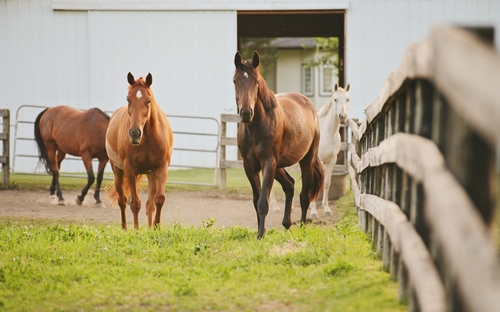Correct posture is extremely important for horses, especially those that perform. A horse stands for about 22 hours per day, according to Equine Wellness Magazine, meaning its posture has more of an effect on its athleticism than its soundness or muscle strength. Not only does poor posture compromise your horse’s performance when it counts, but it’s also a sign of emotional issues.
A proper stance, known as Normal Neutral Posture, keeps the horse’s body stable and balanced. NNP allows a horse to react quickly whenever necessary – for example, when given a command during an event. NNP is a sign your horse is emotionally healthy and strengthens bones, muscles and ligaments. It also improves a horse’s muscle memory so the animal naturally stands in the correct position. NNP saves energy, which the horse can use later during moments of high activity.
To check a horse for NNP, take it to a flat surface and look at its legs. All four cannon bones should be perpendicular to the ground. This puts the horse in a similar position as a four-legged table, allowing its weight to distribute evenly.
“Abnormal Compensatory Postures are often tied to emotional issues.”
Abnormal postures, collectively referred to as Abnormal Compensatory Postures, are often tied to emotional issues like stress, anxiety and depression. In fact, one study from the University of Rennes found depressed horses act in a similar manner to humans. They had poor posture, were indifferent to their typical environment and reacted more strongly than others when placed under stress.
“It turns out that the horses who aren’t feeling well physically or mentally are more likely to spend the majority of their stall time in particular positions,” Carole Fureix, Ph.D., explained to TheHorse.com. “Researchers have already defined specific positions that reflect acute stress, but it now appears that these can indicate chronic stress or pain as well.”
Signs of ACP include:
- Legs that aren’t perpendicular when the horse stands on a flat surface.
- Asymmetrical weight bearing, indicated by differences in hoof size.
- Asymmetrical head and neck positions.
- Distorted spinal contour.
- Unwillingness to stand symmetrically or bear weight evenly across all legs.
- Performance issues or chronic or recurrent lameness with no other identified cause.
Correcting ACP
Improving a horse’s posture is more hands-on than simply fixing its emotional state – it involves additional behavioral conditioning and rehabilitation. Acupuncture, osteopathy, and physical or chiropractic therapy all positively influence an equine’s physiology and mood, but even they don’t target ACP directly.
Instead, owners should try Postural Rehabilitation Intervention, developed by Dr. Judith M. Shoemaker. PRI is based on the Alexander Technique, a therapeutic process to correct human posture, and aims to accomplish four goals:
- Lengthen the equine’s spine.
- Release compression in important areas along the spine.
- Improve the musculoskeletal system so horses can more easily move and breathe.
- Correct neuromuscular patterns so horses have better poise and reduced chronic stress.
If you find your horse needs some sort of intervention to correct its posture, horse healthcare products that support muscle or bone development can help your animal build the strength it needs to break bad habits. Finish Line’s Muscle Tone combines multiple active ingredients to promote strong muscle development.









